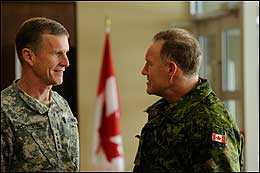Archived Document
II. The Quarterly Context
The winter season, with the influx of additional security forces and civilian support, underscored another transition period in Afghanistan.
While security remained an overarching concern in Kandahar province—the central location of Canada’s engagement in Afghanistan—the security situation improved somewhat during this quarter as a result of increases to both the International Security Assistance Force (ISAF) and Afghan National Security Forces (ANSF). Security improvements were especially noticeable in the districts of Panjwayi and Arghandab.
Nonetheless, the insurgency remained a threat throughout Afghanistan. Complex attacks in Kabul on January 18 and February 26, and the March 13 suicide bombings in Kandahar City, though dealt with professionally by the Afghan National Police, were tragic reminders of this threat. In addition, security concerns continued to inhibit the efforts of the international community in carrying out critical development work.
Canada’s Task Force Kandahar continued to conduct critical counterinsurgency operations in and around heavily populated Kandahar City, and ISAF partnered with the ANSF to bring a stronger security presence to many more villages. At this time last year, ISAF personnel were present in five communities within Canada’s area of operations; at the end of this quarter, forces under Canadian control were providing enduring security in 29 different communities in Kandahar province.
The increased U.S. presence was perhaps most keenly felt during this quarter through Operation Moshtarak (Dari for “together”), an Afghan-led initiative to separate insurgents from the population, provide opportunities for reintegration and further establish government authority in Helmand province, to the west of Kandahar. This operation involved 15,000 troops, including five Afghan battalions, a number of U.S. and U.K. battalions and battle groups, and supporting ISAF troops from several partner countries, including Canada.

Chief of the Defence Staff General Walt
Natynczyk welcomes General Stanley
McChrystal, of ISAF and Commander
of the U.S. Forces in Afghanistan, during an
official visit to Ottawa. Partnerships, such
as the one between Canada and the U.S.,
are essential to helping Afghans rebuild their country.
Also in this quarter, the London Conference on Afghanistan, held on January 28, brought the international community together for a frank discussion on Afghanistan’s future, and concluded with commitments from President Karzai to move forward in a number of areas, including on measures to strengthen the credibility of this year’s parliamentary elections, and further measures on anti-corruption, sub-national governance, political reconciliation and the reintegration of insurgent fighters.